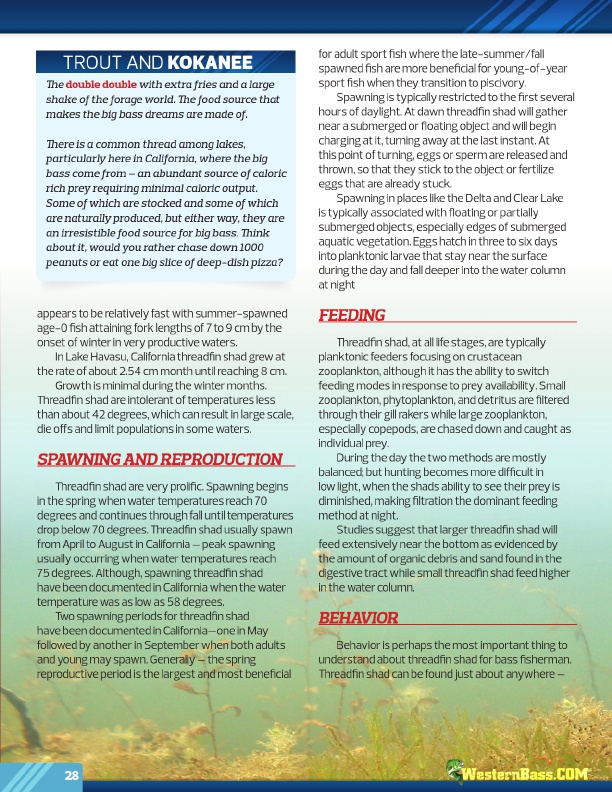
®
TROUT AND KOKANEE
The double double with extra fries and a large shake of the forage world. The food source that makes the big bass dreams are made of.
There is a common thread among lakes, particularly here in California, where the big bass come from – an abundant source of caloric rich prey requiring minimal caloric output. Some of which are stocked and some of which are naturally produced, but either way, they are an irresistible food source for big bass. Think about it, would you rather chase down 1000 peanuts or eat one big slice of deep-dish pizza?
appears to be relatively fast with summer-spawned age-0 fish attaining fork lengths of 7 to 9 cm by the onset of winter in very productive waters.
In Lake Havasu, California threadfin shad grew at the rate of about 2.54 cm month until reaching 8 cm.
Growth is minimal during the winter months. Threadfin shad are intolerant of temperatures less than about 42 degrees, which can result in large scale, die offs and limit populations in some waters.
SPAWNING AND REPRODUCTION
Threadfin shad are very prolific. Spawning begins in the spring when water temperatures reach 70 degrees and continues through fall until temperatures drop below 70 degrees. Threadfin shad usually spawn from April to August in California – peak spawning usually occurring when water temperatures reach 75 degrees. Although, spawning threadfin shad have been documented in California when the water temperature was as low as 58 degrees.
Two spawning periods for threadfin shad have been documented in California—one in May followed by another in September when both adults and young may spawn. Generally – the spring reproductive period is the largest and most beneficial
for adult sport fish where the late-summer/fall spawned fish are more beneficial for young-of-year sport fish when they transition to piscivory.
Spawning is typically restricted to the first several hours of daylight. At dawn threadfin shad will gather near a submerged or floating object and will begin charging at it, turning away at the last instant. At this point of turning, eggs or sperm are released and thrown, so that they stick to the object or fertilize eggs that are already stuck.
Spawning in places like the Delta and Clear Lake is typically associated with floating or partially submerged objects, especially edges of submerged aquatic vegetation. Eggs hatch in three to six days into planktonic larvae that stay near the surface during the day and fall deeper into the water column at night
FEEDING
Threadfin shad, at all life stages, are typically planktonic feeders focusing on crustacean zooplankton, although it has the ability to switch feeding modes in response to prey availability. Small zooplankton, phytoplankton, and detritus are filtered through their gill rakers while large zooplankton, especially copepods, are chased down and caught as individual prey.
During the day the two methods are mostly balanced; but hunting becomes more difficult in low light, when the shads ability to see their prey is diminished, making filtration the dominant feeding method at night.
Studies suggest that larger threadfin shad will feed extensively near the bottom as evidenced by the amount of organic debris and sand found in the digestive tract while small threadfin shad feed higher in the water column.
BEHAVIOR
Behavior is perhaps the most important thing to understand about threadfin shad for bass fisherman. Threadfin shad can be found just about anywhere –
28
http://www.westernbass.com/shared/mag_wb/wb_mag_winter_2017/flipbook.html?pg=41